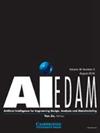Does empathy lead to creativity? A simulation-based investigation on the role of team trait empathy on nominal group concept generation and early concept screening
IF 2.3
3区 工程技术
Q3 COMPUTER SCIENCE, ARTIFICIAL INTELLIGENCE
Ai Edam-Artificial Intelligence for Engineering Design Analysis and Manufacturing
Pub Date : 2023-09-04
DOI:10.1017/S089006042300001X
引用次数: 0
Abstract
Abstract Research on empathy has been surging in popularity in the engineering design community since empathy is known to help designers develop a deeper understanding of the users’ needs. Because of this, the design community has become more invested in devising and assessing empathic design activities. However, research on empathy has been primarily limited to individuals, meaning we do not know how it impacts team performance, particularly in the concept generation and selection stages of the design process. Specifically, it is unknown how the empathic composition of teams, defined here as the average (elevation) and standard deviation (diversity) of team members’ empathy, would impact design outcomes during nominal group concept generation and early concept screening. Therefore, the goal of the current study is to investigate the impact of team empathy on nominal group concept generation and early concept screening in an engineering design student project. This was accomplished through a computational simulation of 13,482 teams of non-interacting brainstorming individuals generated by a statistical bootstrapping technique. This simulation drew upon a design repository of 806 ideas generated by first-year engineering students. The main findings from the study indicated that the impact of the elevation and diversity of different components of team empathy varied depending upon the specific design outcome (number of ideas, overall creativity, elegance, usefulness, uniqueness) and design stage (concept generation and concept screening). The results from this study can be used to guide team formation in engineering design.同理心会带来创造力吗?团队特质共情对名义群体概念产生和早期概念筛选作用的模拟研究
摘要在工程设计界,对共情的研究越来越受欢迎,因为共情可以帮助设计师更深入地了解用户的需求。正因为如此,设计界在设计和评估移情设计活动方面投入了更多。然而,关于同理心的研究主要局限于个人,这意味着我们不知道它是如何影响团队绩效的,特别是在设计过程的概念产生和选择阶段。具体地说,我们不知道团队的共情构成(这里定义为团队成员共情的平均值(高度)和标准差(多样性))如何影响名义群体概念产生和早期概念筛选的设计结果。因此,本研究的目的是探讨团队共情对工程设计学生项目中名义群体概念产生和早期概念筛选的影响。这是通过统计引导技术生成的13,482个非互动头脑风暴个人团队的计算模拟来完成的。这个模拟利用了一个由一年级工程学生产生的806个想法的设计库。研究的主要结果表明,团队共情不同成分的提升和多样性的影响取决于具体的设计结果(创意数量、整体创造力、优雅性、有用性、独特性)和设计阶段(概念生成和概念筛选)。研究结果可用于指导工程设计中的团队组建。
本文章由计算机程序翻译,如有差异,请以英文原文为准。
求助全文
约1分钟内获得全文
求助全文
来源期刊
CiteScore
4.40
自引率
14.30%
发文量
27
审稿时长
>12 weeks
期刊介绍:
The journal publishes original articles about significant AI theory and applications based on the most up-to-date research in all branches and phases of engineering. Suitable topics include: analysis and evaluation; selection; configuration and design; manufacturing and assembly; and concurrent engineering. Specifically, the journal is interested in the use of AI in planning, design, analysis, simulation, qualitative reasoning, spatial reasoning and graphics, manufacturing, assembly, process planning, scheduling, numerical analysis, optimization, distributed systems, multi-agent applications, cooperation, cognitive modeling, learning and creativity. AI EDAM is also interested in original, major applications of state-of-the-art knowledge-based techniques to important engineering problems.

 求助内容:
求助内容: 应助结果提醒方式:
应助结果提醒方式:


